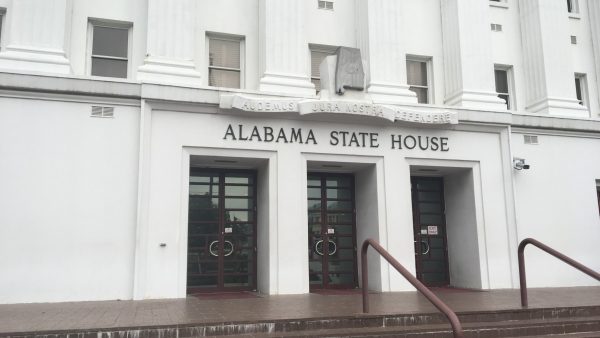Alabama Appalachian Trail
“He could’ve used it twenty years ago when he and a buddy hiked the Appalachian Trail, or A-T as it’s known. It was an arduous two-thousand mile trek.
“There were days where it was more work than it was fun. You had to get up every morning, put on that pack and get the job done.”
It was remembering that five-and-a-half-month hike and being curious about nature from his days in the Boy Scouts that got Lein involved in state conservation. Ultimately, he would help others piece together the Alabama land that now connects to the A-T.
Outdoor tourism officials and state boosters like Stewart Dansby say that’s a no-brainer.
“Most people in the country don’t know much about geography. People need to know the Appalachian Mountains end in north-central Alabama.”
That effort began recently at Mt. Cheaha.
Workers gingerly placed a massive granite and limestone boulder and plaque that commemorate the completion of the Pinhoti Trail. At a dedication ceremony, attorney Mike Leonard – whose idea spans twenty-five years – said the pathway is a window to and for the world.
“I believe in the state of Alabama; I believe in the beauty of this state. And I believe that it is something that the rest of the country needs to know about, they need to appreciate.”
It was the conservationist Benton MacKaye who, in 1921, envisioned the Appalachian Trail as a refuge from the urban environs of the east coast. And now, the Alabama Pinhoti meanders 115-miles to the Georgia border – and ultimately, to Springer Mountain, the original southern endpoint of the A-T in Georgia.
Tom Cosby with the Birmingham Regional Chamber of Commerce says the original northern endpoint was in New Hampshire, but was officially extended. The same, he says, could happen in Alabama.
“Our hope is, with time – I don’t know, 5 years, 10 years, 20 years – at some point perhaps the Appalachian Trail Conference would say, ‘well you know, so many people hike the entire length of the Appalachians. And they don’t end at Springer Mountain, they actually end in Alabama, why don’t we sanction it and say that the Appalachian Trail ends in Alabama?”
Cosby says state officials haven’t officially asked for the trail to be extended into Alabama, but they hope it will become sort of a de facto end and eventually be recognized.
For their part, Georgia officials at a state park near Springer Mountain say they have no position on the Alabama plan – which could siphon people and tourist dollars away.
The Appalachian Trail Conservancy has also not taken an official stand. But Executive Director David Startzell says such a move would require an act of Congress.
“It would have to be an amendment to the National Trails System Act, which provides, a, you know, fairly general description of the route of the trail. But, you know, it’s detailed enough, that clearly an extension into Alabama wouldn’t fit the current definition.”
The National Trails System Act of 1968 places both endpoints at Mount Katahdin, Maine, and Springer Mountain, Georgia. So the wording would have to be changed. Regardless, the Alabama Pinhoti is there for the hiking. No matter what it’s called, it is an uninterrupted path all the way to Maine.
Florida’s 6-week abortion ban will have a ‘snowball effect’ on residents across the South
Abortion rights advocates say the ban will likely force many to travel farther for abortion care and endure pregnancy and childbirth against their will.
Attitudes among Alabama lawmakers softening on Medicaid expansion
Alabama is one of ten states which has not expanded Medicaid. Republican leaders have pushed back against the idea for years.
Birmingham is 3rd worst in the Southeast for ozone pollution, new report says
The American Lung Association's "State of the Air" report shows some metro areas in the Gulf States continue to have poor air quality.
Why haven’t Kansas and Alabama — among other holdouts — expanded access to Medicaid?
Only 10 states have not joined the federal program that expands Medicaid to people who are still in the "coverage gap" for health care
Once praised, settlement to help sickened BP oil spill workers leaves most with nearly nothing
Thousands of ordinary people who helped clean up after the 2010 BP oil spill in the Gulf of Mexico say they got sick. A court settlement was supposed to help compensate them, but it hasn’t turned out as expected.
Q&A: How harm reduction can help mitigate the opioid crisis
Maia Szalavitz discusses harm reduction's effectiveness against drug addiction, how punitive policies can hurt people who need pain medication and more.







